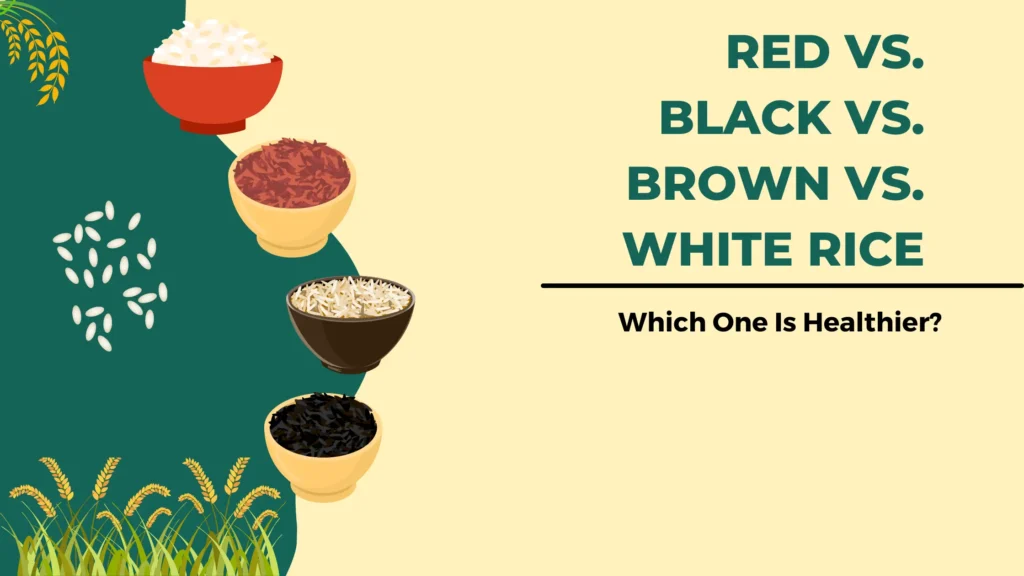Many of us avoid eating rice regularly due to its association with weight gain. In India, polished white rice is the most commonly consumed variety, with its bright, white appearance resulting from extensive processing and polishing. However, other rice varieties — red, black, and brown — are healthier options, with higher levels of fiber, protein, antioxidants, vitamins, and minerals compared to white rice. Choosing the right type of rice can be crucial for maintaining good health. Let’s compare red, black, brown, and white rice to determine which is the healthiest for your overall well-being.
White vs. Red vs. Brown vs. Black: Know the Pros and Cons
Nutritionist provides insights into the pros and cons of each rice variety, helping us make informed choices based on health goals.
White Rice: The Traditional Staple
Pros of White Rice:
Provides Energy:
White rice is a simple carbohydrate, meaning your body can easily break it down and absorb the carbohydrates quickly. This makes it an excellent choice for those needing a quick energy source, such as athletes or people engaged in long-duration physical activities.Gets Absorbed Quickly:
White rice lacks the bran, germ, fiber, and fat content found in whole grains, making it easier to digest. For individuals with digestive issues, white rice can help reduce bloating and irritation. It’s also useful for those experiencing symptoms like severe diarrhea.Easily Accessible:
White rice is typically less expensive than its whole-grain counterparts and is widely available, making it accessible to people from all economic backgrounds. It’s versatile and easy to prepare, making it a convenient option for many.
Cons of White Rice:
May Cause Weight Gain:
White rice has a high-calorie content per serving, making it calorie-dense. This can be challenging for those on a weight loss regimen.Affects Blood Sugar Levels:
White rice has a high glycemic index (GI), meaning it digests quickly and raises blood sugar levels. Consuming it frequently may increase the risk of developing type 2 diabetes. A study published by the American Diabetes Association found that people who ate more than five servings of white rice per week had a 17% higher risk of developing diabetes than those who ate less than one serving per month.
Brown Rice: The Whole-Grain Choice
Pros of Brown Rice:
Good for Diabetics:
Brown rice has a low glycemic index, making it beneficial for people with diabetes. It can reduce insulin spikes and help manage blood sugar levels effectively.Prevents Obesity:
Brown rice is often favored by those trying to lose weight. Its high manganese content aids in the synthesis of body fat, lowers body fat percentage, and contributes to a healthier BMI. It also promotes the production of healthy HDL cholesterol.Heart-Healthy:
Brown rice helps maintain cardiovascular health by lowering harmful cholesterol levels, reducing the risk of heart disease, blocked arteries, strokes, and other vascular conditions. It also helps in treating hypertension and prevents the hardening of arteries (atherosclerosis).
Cons of Brown Rice:
- Longer Cooking Time:
Brown rice takes longer to cook than other rice varieties, which can be a drawback for those looking for a quick meal.
Brown Rice: The Whole-Grain Choice
Pros of Brown Rice:
Good for Diabetics:
Brown rice has a low glycemic index, making it beneficial for people with diabetes. It can reduce insulin spikes and help manage blood sugar levels effectively.Prevents Obesity:
Brown rice is often favored by those trying to lose weight. Its high manganese content aids in the synthesis of body fat, lowers body fat percentage, and contributes to a healthier BMI. It also promotes the production of healthy HDL cholesterol.Heart-Healthy:
Brown rice helps maintain cardiovascular health by lowering harmful cholesterol levels, reducing the risk of heart disease, blocked arteries, strokes, and other vascular conditions. It also helps in treating hypertension and prevents the hardening of arteries (atherosclerosis).
Cons of Brown Rice:
- Longer Cooking Time:
Brown rice takes longer to cook than other rice varieties, which can be a drawback for those looking for a quick meal.
Red Rice: The Nutrient-Rich Option
Pros of Red Rice:
Boosts Immunity:
Red rice is rich in antioxidants and magnesium, which aid in preventing and treating various illnesses. It also contains selenium, which helps in defending the body against infections.Prevents Asthma Attacks:
The high magnesium content in red rice improves oxygen circulation, which can help prevent asthma attacks.Supports Bone Health:
Red rice is an excellent source of calcium and magnesium, making it ideal for improving bone density and preventing bone-related disorders such as osteoporosis and arthritis.
Cons of Red Rice:
May Cause Indigestion:
Due to its high fiber and protein content, consuming red rice in excess might lead to indigestion, bloating, and stomach discomfort.Higher Cost:
Red rice is generally more expensive than white rice and other varieties, making it less economically accessible.
Black Rice: The Antioxidant Powerhouse
Pros of Black Rice:
Rich in Antioxidants:
A study published in the Journal of Medicinal Food found that black rice has the highest level of antioxidants compared to other rice varieties. These antioxidants help fight oxidative stress, reduce the risk of Alzheimer’s disease, and protect against certain cancers, such as colorectal and breast cancer. Black rice also contains additional plant compounds, such as flavonoids and carotenoids, which have antioxidant properties.Rich in Amino Acids:
Black rice contains about 18 different types of amino acids, which are essential for various bodily functions, including cell regeneration and repair, and help maintain stable energy levels.Good for Eye Health:
Black rice contains carotenoids like zeaxanthin and lutein, along with vitamin E, which are beneficial for eye health. They protect against age-related macular degeneration and reduce the damage caused by UV rays.
Cons of Black Rice:
Limited Availability:
Black rice is not as widely available as other varieties, making it harder to find in local markets.Higher Cost:
Similar to red rice, black rice is more expensive compared to white rice and other varieties.
Red vs. Black vs. Brown vs. White Rice: Which One Is Healthier?
When it comes to determining the healthiest rice, red, black, and brown varieties clearly have an edge over white rice. These types are richer in fiber, protein, antioxidants, and essential vitamins and minerals. The primary issue with white rice is its high level of processing, which strips it of most nutrients and makes it less filling compared to other rice types.
However, the choice ultimately depends on individual health goals and preferences. Here’s a summary to help you decide:
- For quick energy and easy digestion: White rice is a good option.
- For managing diabetes or maintaining heart health: Brown rice is beneficial.
- For boosting immunity and bone health: Red rice is a great choice.
- For antioxidant benefits and eye health: Black rice is the winner.
How to Make the Healthiest Choice
To make the best decision for your diet, consider the following:
Think About Your Health Goals: If you aim to lose weight, manage diabetes, or improve heart health, brown rice may be your best option. For those looking to boost immunity or prevent bone-related issues, red rice is ideal. If your focus is on maximizing antioxidant intake, black rice should be your go-to.
Consider Your Budget: White rice is the most cost-effective option, while red and black rice may not be as accessible due to higher costs.
Factor in Availability: White rice is the most widely available, followed by brown rice. Red and black rice may require searching specialty stores or online options.
Watch Your Portions: Regardless of the type, rice is calorie-dense. It’s essential to control portions to avoid excess calorie intake.
Pair with Other Nutrient-Dense Foods: Combine rice with vegetables, lean proteins, and healthy fats to create balanced meals.
Conclusion
Each variety of rice offers unique benefits and drawbacks. Red, black, and brown rice are generally more nutritious than white rice, providing higher levels of fiber, protein, and essential nutrients. However, the best choice depends on your health needs, personal preferences, and lifestyle.
Understanding the pros and cons of each rice type can help you make informed decisions and include rice in your diet in a way that aligns with your health goals. Remember, moderation and a balanced diet are key to overall well-being. Whether you choose red, black, brown, or white rice, consider how it fits into your broader nutritional needs and enjoy the health benefits of this versatile grain.



